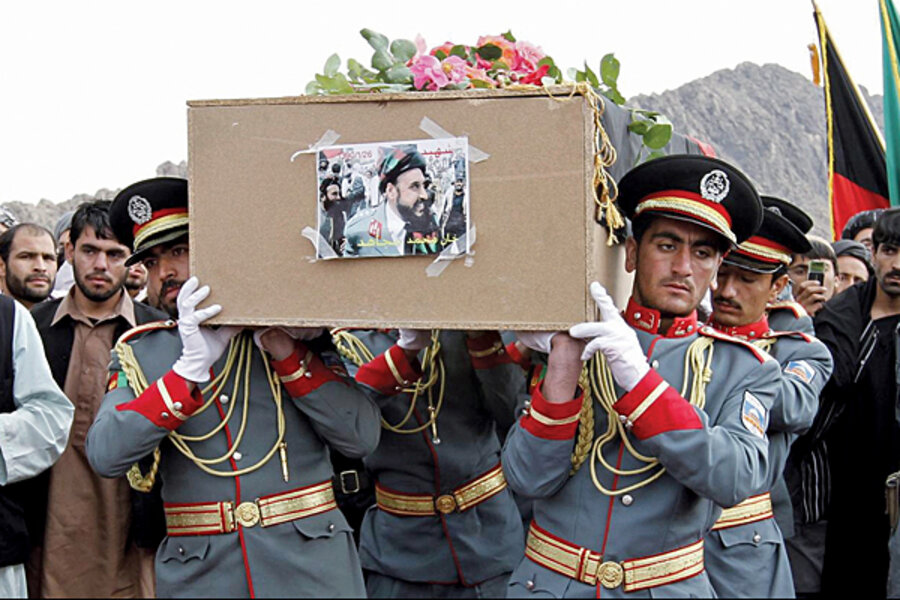Afghan security forces still not so secure after NATO boost
Loading...
| Arghandab, Afghanistan
At the provincial police headquarters in Kandahar City, Gen. Khan Mohammad Mujahid enjoyed a well-appointed office with carpets kept meticulously clean despite a constant parade of policemen traipsing through in grimy boots. As the top police commander in one of Afghanistan's most violent provinces, he projected the order he hoped to instill in Kandahar.
On a Monday morning in April, his American mentor, a US Army lieutenant colonel, proudly looked on as Mujahid spoke confidently of security gains during the past several months of the surge of new troops. But with the realism of a respected fighter who first cut his teeth battling the Soviets, he pointed out the challenges ahead.
"We have destroyed and eradicated [militant] safe havens, so they don't have bases [from which] to plan their attacks," he said of the surge's effect on Kandahar. "If the US forces withdraw or remain here in smaller numbers, the police are not capable of keeping the situation secure. They need more time for training and then they will have the ability to keep the situation stable. The police are not yet professional."
The following Friday, inside the fortified police compound, a man dressed in a police uniform approached the general, hugged him, and detonated a suicide bomb. The assassination of Mujahid was one of many recent incidents that have shaken confidence in the Afghan National Security Forces. Though having grown considerably in size and ability, the ANSF is dogged by questions of its trustworthiness and how, as NATO reduces its support, it can take full responsibility for security – from local policing to national protection – as scheduled for 2014.
Since President Obama announced the surge in December 2009, there has been a tremendous push to develop the ANSF. By the summer of 2010, the size of the forces had grown by 15 percent, to 224,000; they are expected to reach 305,000 by October.
Until recently, the Afghan Army received the lion's share of foreign attention. It was seen as more important than the police in suppressing the insurgency. And as a military group, NATO was better equipped to train soldiers than police.
Between fiscal years 2002 and 2009, the United States Defense and State Departments invested $14.2 billion in training and equipping the Afghan Army, double the $7 billion given to police. The investment was apparent to Baktullah Haqdust, who still remembers the first time he saw the Afghan National Army: "I was young when the Americans came here. I was sitting in a shop with my brother and I saw the ANA pass by. I asked if they were Americans." He was 15 years old at the time, but as soon as he turned 18 he enlisted. Five years later, he's seen combat in several provinces and is now an Afghan infantry sergeant in this region, which, until recently, was home to some of the country's most brutal fighting.
Sergeant Haqdust says he saw the worst fighting in Uruzgan Province, north of Kandahar. But when he arrived in the Arghandab in the surge of reinforcements last fall, he says: "It was all-out war. You'd get shot at three times before your patrol even walked a few kilometers."
For Afghan police, who've traditionally suffered higher losses than the Afghan Army because they tend to operate in smaller numbers with less equipment, the situation in Arghandab was no less perilous. In his first few months working as a policeman here, Janan Alokozai took two bullets in the leg during a gun battle with the Taliban. Later, he was kidnapped by the Taliban and held three days before escaping through a window.
As the situation quiets in the Arghandab, many Afghans say they're pleased with how the Army performed against the insurgency. But they widely view the police as corrupt. After his ordeal, Mr. Alokozai quit the national police because he didn't trust his supervisor: "I wanted to save our area and its people from the militants." So when the US formed an Afghan Local Police unit in Lowy Manarah, his home village here, he joined.
"In the cities, the Afghan National Police are good, but [in the villages] they just give them a gun and then say they're ANP," says Afghan Army Sgt. Sayefuddin Uzbek. "If we go on a patrol we have all our gear like body armor and a helmet, but the ANP don't have any of that."
A larger issue looms of what the ANSF will look like as NATO reduces its Afghan commitment. The Afghan government relies almost entirely on foreign support to maintain its security forces. Mr. Obama requested $11.6 billion from the US Congress for 2011 to expand, train, equip, and sustain Afghan security forces. The Afghan government – with tax revenues totaling only $1.8 billion – can pay little of its security expenses.
"If I don't have [foreign] help ... [t]here would be no budget, there would be no security," says Haji Shah Mohammad Ahmadi, the Arghandab district governor. "We wouldn't have anything. Anything we have now is because of ... foreign people."
Editor's note: This is part of a cover story project that is a report card on the surge, with on-the-ground reports from three facets of the surge: the US military, the Afghan security forces, and the Afghans themselves.





